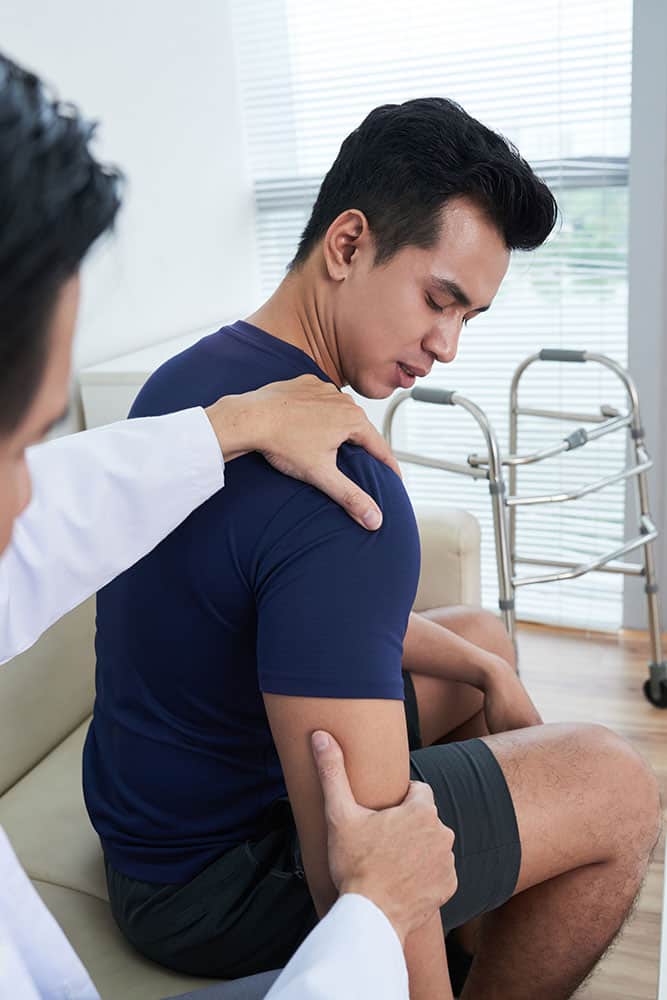Shoulder Pain
At Kennedy Health, we specialize in providing comprehensive shoulder pain relief, helping you overcome discomfort and regain optimal shoulder function. Our experienced medical professionals are dedicated to diagnosing and treating various causes of shoulder pain, ensuring personalized care and effective relief.
Causes of Shoulder Pain
Rotator Cuff Injuries
Rotator cuff tears, strains, or tendinitis can result from repetitive overhead motions, aging, or traumatic injuries, causing pain and limited range of motion.
Shoulder Impingement
Impingement occurs when the rotator cuff tendons or bursa become compressed between the bones of the shoulder joint, leading to inflammation, pain, and difficulty raising the arm.
Frozen Shoulder
Also known as adhesive capsulitis, frozen shoulder causes stiffness, pain, and limited mobility in the shoulder joint, often following a period of immobilization or certain medical conditions.
Shoulder Arthritis
Osteoarthritis, rheumatoid arthritis, or post-traumatic arthritis can cause chronic shoulder pain, stiffness, and inflammation due to cartilage degeneration or autoimmune responses.

Types of Diagnoses and Conditions
Rotator Cuff Tears
Partial or complete tears in the rotator cuff tendons, resulting in pain, weakness, and limited shoulder movement.
Shoulder Instability
Shoulder instability occurs when the structures that hold the joint in place are weakened or injured, leading to recurrent dislocations, pain, and a feeling of the shoulder “slipping.”
Shoulder Bursitis
Inflammation of the fluid-filled sacs (bursae) in the shoulder joint, causing pain, swelling, and limited mobility.
Biceps Tendonitis
Inflammation or irritation of the biceps tendon, resulting in anterior shoulder pain and discomfort, often worsened with overhead activities.
Symptoms Associated with Shoulder Pain
Pain and Discomfort
Persistent or intermittent shoulder pain, ranging from dull aches to sharp, stabbing sensations, often worsened with movement or certain positions.
Weakness or Instability
Reduced strength or a feeling of shoulder instability, making it challenging to perform tasks that require arm movement or support.
Limited Range of Motion
Difficulty raising the arm, reaching overhead, or performing routine activities due to pain, stiffness, or weakness in the shoulder.
Swelling and Inflammation
Joint swelling, warmth, and redness due to inflammation within the shoulder joint.
Treatment Options
Medication Management
Nonsteroidal anti-inflammatory drugs (NSAIDs), pain medications, corticosteroids, or muscle relaxants may be prescribed to manage pain, reduce inflammation, and improve shoulder function.
Physical Therapy
Our experienced physical therapists design personalized exercise programs to improve shoulder strength, flexibility, and stability, reducing pain and enhancing mobility.
Shoulder Joint Injections
Intra-articular injections, such as corticosteroids or hyaluronic acid, may be recommended to provide localized pain relief, reduce inflammation, and improve joint function.
Lifestyle Modifications
Our medical professionals provide guidance on ergonomic adjustments, proper posture, and techniques to avoid or modify activities that exacerbate shoulder pain.
Shoulder Athroscopy
In some cases, minimally invasive shoulder arthroscopy may be necessary to repair damaged tissues, remove inflamed bursa, or stabilize the joint.
Surgical Intervention
In severe cases where conservative treatments are ineffective, surgical options, such as rotator cuff repair, labrum repair, or shoulder replacement, may be considered to alleviate pain, restore function, and improve overall shoulder health.

Take the first step toward effective shoulder pain relief. Contact Kennedy Health today to schedule a consultation and explore the treatment options available to help you find relief, regain mobility, and embrace an active lifestyle. Trust our expertise and commitment to your well-being as we guide you on the path to a healthier, more comfortable future.

